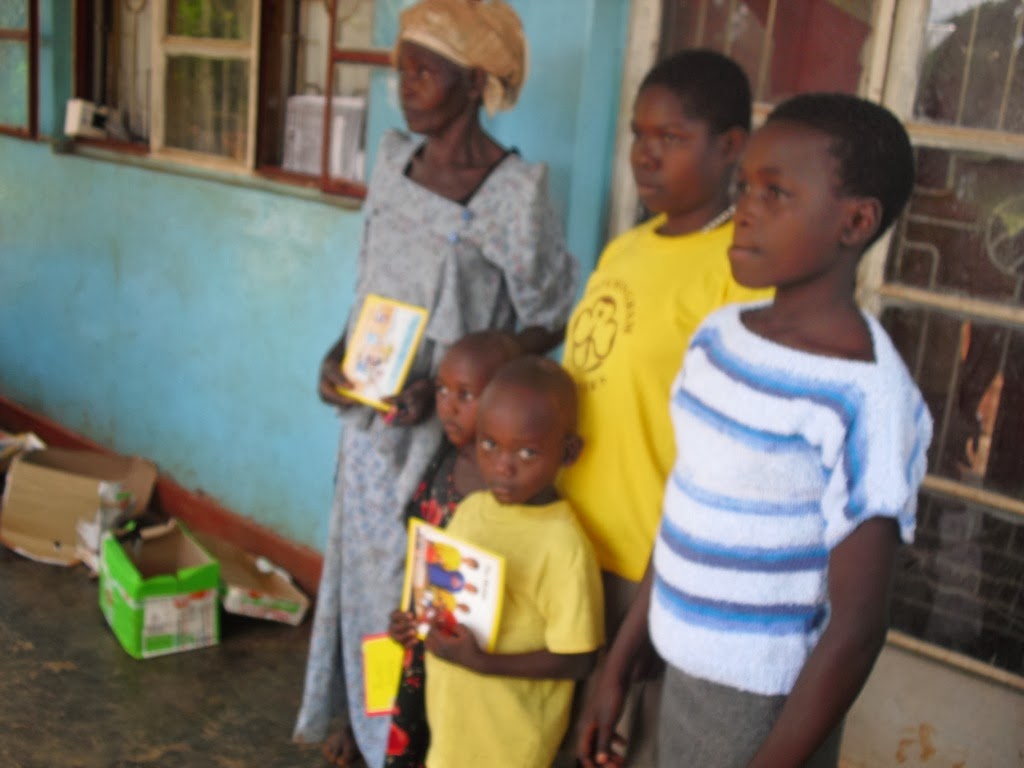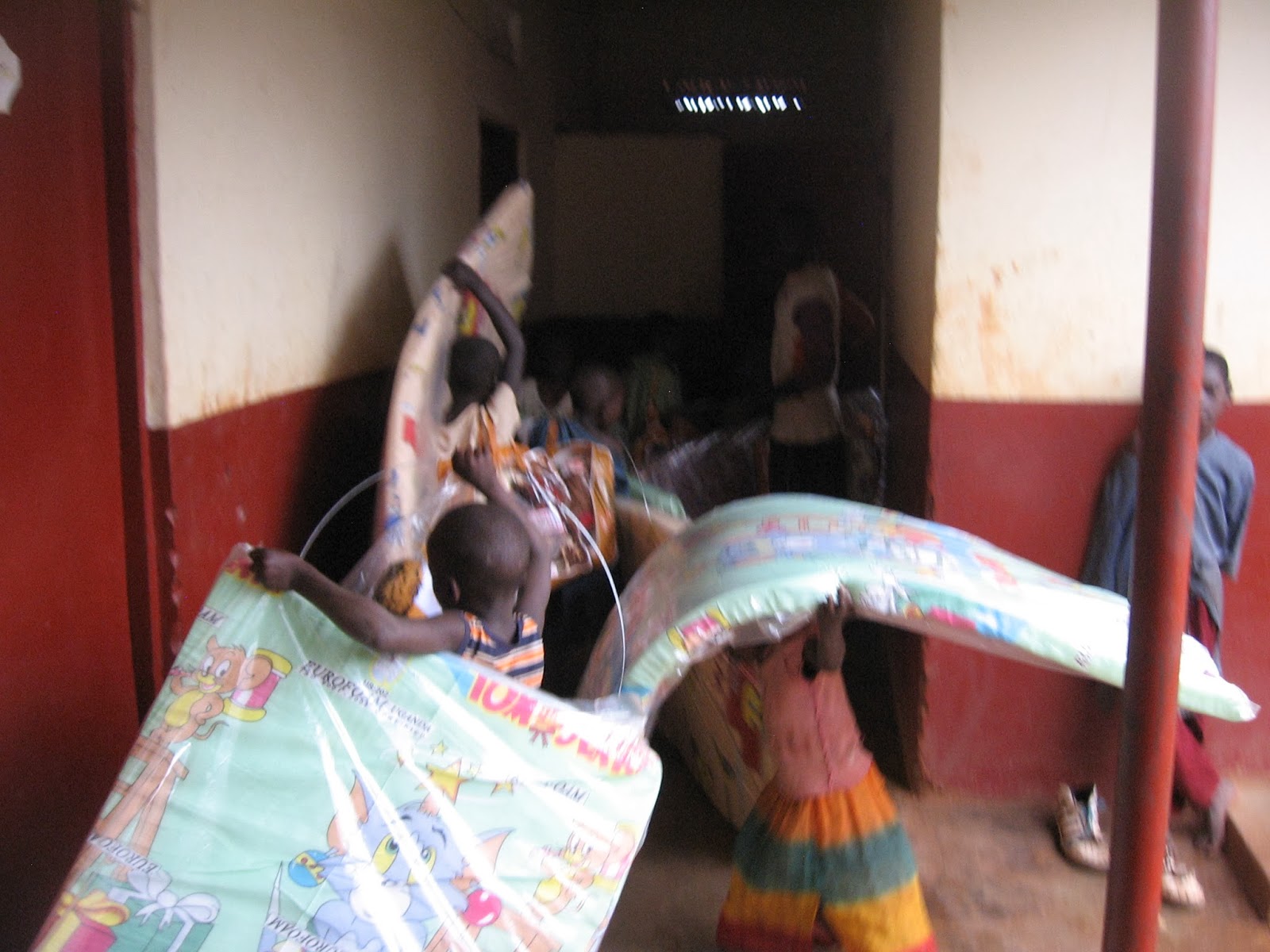http://www.lebendigehoffnung.at/downloads2/URICT_Newsletter012014.pdf
URICT Uganda
Wednesday, 5 February 2014
Monday, 21 October 2013
Fruit growing for Nutrition and Income generating in Kamuli
PROJECT
URICT UGANDA is a registered NGO founded 2005, focusing on rural women’s
empowerment through skills training.
URICT proposes to establish organic fruit farming (oranges and mangoes) in Bukyerimba
village (pop. 7,567, 2010), Kamuli
District, Eastern Uganda, and provide training for 180 farmers
(75% women).
Only 50km from Jinja, Bukyerimba itself is poor and isolated, with an 89.7% illiteracy rate. Crops are plagued by pests and diseases
(tristeza, wooly white flies, aphids), there is no health
center or school, and the
nearest clean water is 3km away.
Despite
such
setbacks,
participatory rural research indicates that farmers are keen to
increase food security, and that the soil is suitable for fruit cultivation.
With startup support, and expertise from a US student in tropical
pest and disease management, this community can produce fruit for
home consumption and sales - ensuring
economic self-sufficiency for the many women-headed households of Bukyerimba.
Although fruit and vegetable
production is the main economic activity,
farmers have received neither extension services nor training.
However, URICT’s discussions with NAADS officials indicate
that assistance will be forthcoming if
the villagers start a self-help project. This will ensure sustainability
after funding ends. The local
NAADS Director has even agreed to be a project leader.
· Establish organic fruit farming as viable means of employment,
especially for women
· Increase
productivity and quality of fruit through superior
varieties/ technology
· Improve
nutrition levels through supply of improved quality fruit
· Reduce
postharvest losses, and improve market
access
· To provide fruit seeds, farm inputs,
and training in organic farming
methods
· To
attract support of government
agencies like NAADS
· To
establish a forum for
collective farming and information
sharing
· To establish ongoing information exchanges with overseas partners
· Training: In disease and pest
control, agricultural best practice, record keeping, marketing
· Creation
of a stakeholders’ forum so farmers can jointly tackle problems. A committee
of 11 farmers (nine will be women)
will be meet monthly
· Printing
booklets for research and reference under
guidance of the local Ugandan
university student, who is from this
village
· Improved
crop productivity and quality
· Raised incomes, women will become self-supporting, and learn leadership and management skills
· Learning
new farming methods will
increase yields
· Collective
bargaining power will ensure farmers can better access and compete on
local markets, access research findings, and identify common problems
· Improved nutrition, food security,
more effective environmental management
· Villagers will gain access to ongoing extension services,
ensuring sustainability
Safe Motherhood/Fistula and Maternal Health in Buyende and Kamuli
Reaching the Forgotten Face of Women and Girls with Fistula: Adapting Culture to Prevention of Fistula and Maternal Health Among People in Busoga Districts
Over the last 5 years Fistulas in Uganda has stagnated at 6.4% among women between 14yrs – 44yrs, and in Kamuli, a slight rise in has been recorded in Buyende. Fistulas in Uganda among Rural women is growing fastest especially in villages where there is no nearby qualified health workers and medical services. The groups facing fistula includes women, teenage mothers and younger girls above/below 18 years. Currently Fistula has lead to break up of marriage or relationships, widowed, divorce or separated, orphans, single mothers and father’s home life style. Research has also shown that risky sexual behavior, lack of medical services supplies and treatment, women slavery home works, traditional thinking, poverty, early marriage and pregnancy causes fistula to be a recurring health problem. Moreover, these higher risk sexual practices are common in Kamuli and Buyende Districts, Eastern Uganda. For instance, Kamuli district has the highest number of single orphans without mothers, families cared by father without mother, high maternal death, high fertility rates, in
Uganda, which is a pointer to high death of women caused mainly by fistula and HIV/AIDS, because in Uganda’s situation, pregnancy is one of the most objective indicators of unsafe sex practices.
Uganda, which is a pointer to high death of women caused mainly by fistula and HIV/AIDS, because in Uganda’s situation, pregnancy is one of the most objective indicators of unsafe sex practices.
Moreover, this particular group has hitherto been relatively underserved with anti-fistula and maternal health messages and services. Most anti-Fistula messages and health services have not focused on this particular group, consequently contributing to the increase in fistula among rural/villager women.
Additionally, only 12% of the population countrywide is aware of their Fistula status,. As a result, services to reach this particular group are still limited, and in need of scaling up. These gaps in service delivery provide challenges as well as opportunities to reach out to this underserved
rural/villager women and girls population.
Using participatory, culturally adapted and gender sensitive approaches, this project will address these gaps by reaching out to this hitherto underserved group with culturally relevant and appropriately tailored Fistula and Maternal Health Problems (FMHP) messages and services. The
main approach will be to integrate Fistula as part of a comprehensive reproductive health package to the target population. URICT-Uganda in collaboration will carry out the interventions with its partners. They will include culturally sensitive information and behaviour change messages
on safer sex practices, services to address gaps in Fistula management/treatment, Refer women with
Fistula to get treatment in Kamuli Mission Hospital, family planning. URICT is a proven leader in SRHR in Kamuli Eastern Uganda, and its static Rural Health Center in Kitayunjwa Sub-county, Busota Village, and Kamuli District will act as focal points for accessing care and delivering services to communities that are more distant.
Project Goal
The goal is to contribute to a reduction in the of Fistula among rural/villager women and teenage mothers, by promoting Fistula and maternal health Education and Outreaches, Training Traditional Birth Attendants (TBAs) will change rural women health practices. It is expected that this intervention will contribute to Fistula reduction, increase Safe motherhood health method use and promote greater use of TBA’s services in the villages as immediate nearby medical health solution.
Area of Coverage
The coverage area is in Kamuli and Buyinda districts respectively. In Kamuli the area of coverage will include 3 sub counties, namely Mbulamuti near banks of lake Kyoga, Butansi and Kitayunjwa. In Buyinda the area of coverage will be Nkondo and Bukungu and Irundo sub counties all near
lake Kyoga. The secondary target will be the opinion leaders and political leadership in the area to know the urgent need for opening a fistula hospital in Busoga Region to save mothers of the world dying every day in big number.
Strategic Partnerships
Strategic partnerships has been already established with Kamuli General Hospital and the respective district/local Health Leaders, The AFYA American Foundation, Uganda Injure Birth Project UK (Dr. Brian Hancock, Dr. Glyn Constantine and Nurse Brenda U.K) TASO-Jinja to cater for HIV affected women needs, and the St. Francis Hospital Njeru Jinja (SFH) to provide care and support women with Fistula and Maternal Problems
URICT - Joy Orphanage Home & Educational Center
URICT – Joy Orphanage Children’s Home & Educational Center
The Government of Uganda officially issued us with a
registration certificate as Charity Organization in the name of URICT - Uganda.
As a registered Organization, the government further gave us a permission to
open up a fully operational Orphanage Children’s Home for HIV/AIDS Orphans. The
Orphanage owns 283 acres of land. Currently, URICT is looking after 50 HIV/AIDS
Orphans and we have 8 volunteers who help me on the daily basis. Our Orphanage
is supported through charitable donations from people like you. Through the
Sponsorship Program you can touch the life of a child forever. Without the
funding from sponsors, URICT will not be possible. The Sponsorship Program
gives you an opportunity to make a life long impact on the life of a child.
100% of your sponsorship dollars go toward your child's education & care
through the General Operating Fund. There are no administrative fees deducted
from your donation. Be assured that your child will receive not only an
education but, most importantly, an excellent education foundation.
We are accountable to every person who donates whatever
they can. The Books of accounts are accessible and available to anyone. The
financial statements are published annually and sent to all our friends and
partners. Our books of account are kept by a certified accountant. These books
of accounts are audited by CLAYTON & Company (Certified Public Accountants)
Ending Child and Human Sacrifice in Busoga
Ending Child and Human Sacrifice in
Busoga Eastern Uganda
URICT was formed to assist the rural
people and villagers get access to information, fight the digital age, advocate
for their fundamental rights and improve their health and socio-economic status
and lives using an integrated approach especially through Information and
Communication and Education
URICT ‘s vision is “A Uganda with
informed and educated rural people/villagers accessing quality, adequate and
equitable Information and Communication and Education services at the same time
seeing that their rights as disadvantaged peopled are respected by state of
Uganda” while URICT Mission is “To contribute towards raising the level,
Quality & Equity of Information and Communication and Education Services
and advocate for the rights of rural people and villagers in Uganda through
increasing access, advocacy, economic empowerment and working with other
development actors”
URICT
would like to introduce you to her 10years program to end Child Human
Sacrifice. Child Human sacrifice is the act of killing human beings as part of
a religious ritual (ritual killing). Its typology closely parallels the various
practices of ritual slaughter of animals (animal sacrifice) and of religious
sacrifice in general. Child Human sacrifice has been practiced in various
cultures throughout history. Victims were typically ritually killed in a manner
that was supposed to please or appease gods, spirits or the deceased, for
example as a propitiatory offering, or as a retainer sacrifice when the King
servants die in order to continue to serve their master in the next life.
Closely related practices found in some tribal societies are cannibalism and
headhunting.
The
idea of human sacrifice has its roots in deep prehistory, in the evolution of
human behaviour. Mythologically, it is closely connected, or even fundamentally
identical with animal sacrifice. Walter Burkert has argued for such a
fundamental identity of animal and human sacrifice in the connection of a
hunting hypothesis which traces the emergence of human religious behaviour to
the beginning of behavioral modernity in the Upper Paleolithic.
Unlike
in the past where parents could just buy a doll for their children and they
could appreciate them. Today, this is not the case in Uganda following the
rampant child abduction, reportedly for sacrifice. Children in Uganda now adore
their parents full time protection than gifts.
Busoga
Eastern Uganda leads in the act of Child Human Sacrifice, with over 2-3
children sacrificed every week. The Ugandan police and the authorities have not
properly responded to end Child Human Sacrifice, because many of the rich,
wealth and corrupt government officials are directly involved in sacrificing
children in Uganda.
URICT
has opened up a program to take information to the people, and tell them that
Child Human Sacrifice should end and a new era has come. That way the witch
doctors and all the parents involved in Child sacrifice will hear the call.
Subscribe to:
Comments (Atom)

















